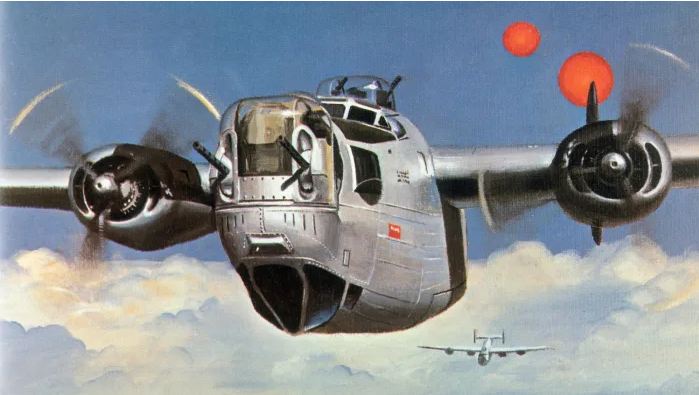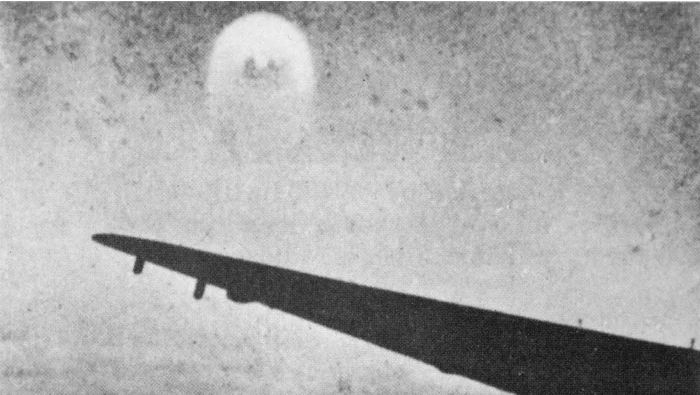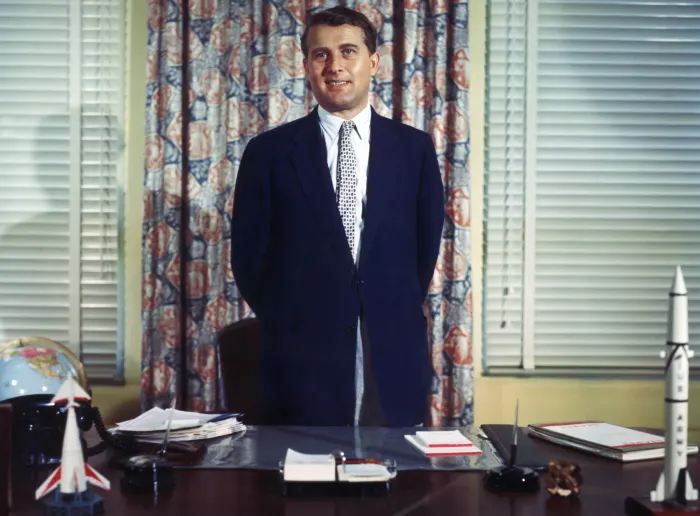Mysterious
UFOs Seen by WWII Airman Still Unexplained
They
were cigar-shaped, glowed red and could turn on a dime.
Which ruled out even the most sophisticated rockets of
the time.
by Adam Janos
It
was nearly the end of World War II. But for the airmen
of the 415th Night Fighter Squadron, it felt more like
the beginning of War of the Worlds.
Lt.
Fred Ringwald was the first to see it. He was riding as
observer in a night fighter piloted by Lt. Ed Schlueter,
with Lt. Donald J. Meiers on radar. It was a late November
evening in 1944, partly cloudy with a quarter moon. They
were roaming the Rhine Valley just north of Strasbourg
on the French-German border when Ringwald said, “I
wonder what those lights are, over there in the hills,”
according to an American Legion Magazine story on the
sightings from 1945.
There
were eight to 10 of them in a row, glowing fiery orange.
Then Schlueter saw them off his right wing. They checked
with Allied ground radar, but they registered nothing.
Thinking that the lights might be some kind of German
air weapon, Schlueter turn the plane to fight…only
to have the lights vanish.
At
first, the men said nothing, fearing they’d be ostracized.
But then the sightings spread through the unit.

A plane of the 415th Night Fighter Squadron circa 1944.
The U.S. Army Air Force
More
crews, more sightings
On
December 17, 1944, near Breisach, Germany, a pilot was
flying at approximately 800 feet when he saw “5 or
6 flashing red and green lights in ’T’ shape.”
The lights seemed to follow him, closing in “to about
8 o’clock and 1,000 ft.” before disappearing
as inexplicably as they came.
Then
on December 22nd, two more flight crews sighted lights.
One crew, near Hagenau, reported two lights in a large
orange glow, seeming to rise from the earth to 10,000
feet, tailing the fighter “for approximately two
minutes.” After that, the lights, “peel off
and turn away, fly along level for a few minutes and then
go out. They appear to be under perfect control at all
times,” according to Keith Chester’s Strange
Company: Military Encounters with UFOs in World War II.
And
then there was Lt. Samuel A. Krasney’s experience:
a wingless cigar-shape object, glowing red, just a few
yards off the plane’s wingtip. Lt. Krasney, justifiably
spooked, instructed the pilot to attempt evasive maneuvers,
but the glowing object stayed right next to the jet for
several minutes before it “flew off and disappeared.”
Eventually,
the airmen named the lights: foo fighters, inspired by
the comic strip “Smokey Stover,” in which Smokey
(a firefighter) would often declare, “Where there’s
foo, there’s fire.”

An illustration depicting the December 22, 1944 encounter
with 'foo fighters'
during a daylight bombing raid on Germany during World
War II.
Chronicle/Alamy Photo
The
‘combat fatigue’ explanation
An
Associated Press reporter broke news of the foo-fighter
sightings on January 1st, 1945, and theories about their
origins quickly abounded: The sightings were flares, or
weather balloons or St. Elmo’s Fire—a phenomenon
where a light appears on the tips of objects in stormy
weather. But the members of the 415th rejected all those
theories. Flares and weather balloons can’t track
planes like these objects could, and they’d seen
St. Elmo’s fire and could distinguish the two.
Then
there were those who claimed that the airmen were suffering
from “combat fatigue,” a polite way of saying
that war stress was driving them insane. But there was
scant evidence to suggest collective psychosis: The 415th
had an otherwise excellent record, and when a reporter
for American Legion Magazine went to report on the squadron
he described them as “very normal airmen, whose primary
interest was combat, and after that came pin-up girls,
poker, doughnuts and the derivatives of the grape.”
Lt.
Krasney’s son, Keith Krasney, says his late father
didn’t fit the stereotypical profile of a UFO theorizer.
In fact, he never even suggested that the glowing wingless
cigar-like object that flew next to his plane was extraterrestrial
in origin.
“He
was very level-headed, very analytical,” says Krasney
of his father, adding that he kept a notebook where he
wrote about (and drew) his foo-fighter sighting. But although
he never seemed prone to conspiracy theories, Krasney
says his father was open to one: “He entertained
the idea that it could be late-breaking German technology.
He did express the view that there were a lot of things
during the war that were kept quiet.”

This
photo is said to show a 'foo-fighter' observed by a German
pilot in May 1945, near Karnten, Germany.
Chronicle/Alamy Photo
Was
it the work of Nazi astrophysicists?
Holding
Nazi Germany responsible for the flying glowing orbs isn’t
too far-fetched. For one thing, the sightings took place
over Nazi-occupied Europe, at a time when Germany’s
Luftwaffe was making tremendous strides. Then there’s
the fact that the sightings stopped once the German army
was defeated.
But
the most compelling link to the foo fighters might be
Wernher von Braun, a 32-year-old wunderkind rocket engineer.
Von Braun helped the Nazis develop the V-2 rocket: a long-range
guided ballistic missile that Hitler was using in 1944
against Belgium and other parts of Allied Europe. It’s
not to hard imagine pilots—unfamiliar with long-range
ballistics—comparing these rockets to a cigar-like
wingless planes. The V-2 could even explain the glow,
since its tail emitted a long burning plume.
Nicholas
Veronico, an author who has written several books on military
aviation history, says that explanation comes up short.
“The
V-2 rocket doesn’t have the maneuverability,”
he says. “It couldn’t turn on a dime and change
its acceleration pattern. Once it started burning, it
burned and produced thrust at one rating.”
Nothing
in Nazi Germany’s military-aviation arsenal can explain
the foo-fighter description, Veronico says. One airman’s
observation from the time—that the foo fighters follow
the fighters so closely as to seem almost magnetized to
them—is particularly confounding, given that “there
just wasn’t the propulsion or metallurgical technology
that could enable something like that.”

German-born
rocket scientist Wernher von Braun, who was brought to
the
United States to work for the U.S. Army circa 1946.
Archive Photos/Getty Images
And
yet von Braun’s career after World War II is worth
considering. Following the collapse of the Third Reich,
the engineer was recruited to be part of Operation Paperclip,
a clandestine U.S. military program that spared 1,600
Nazi scientists prosecution for war crimes, moving them
instead into the American military, where their past was
whitewashed to the public.
By
1952, von Braun had reinvented himself as a space-flight
advocate, writing a piece that year in Collier’s
magazine declaring that “within the next 10 or 15
years, the earth will have a new companion in the skies,
a man-made satellite that could be either the greatest
force for peace ever devised, or one of the most terrible
weapons of war—depending on who makes and controls
it.” His prediction proved overly conservative: The
Soviets launched Sputnik 1 only five years later. Von
Braun helped the U.S. Army launch Explorer 1 shortly thereafter.
By 1960 he was with NASA, where he became the chief architect
on Saturn V—the rocket that sent Neil Armstrong and
the Apollo 11 crew to the moon.
As
von Braun recast himself as an American patriot, his career
in the Nazi party shadowed him, an ambiguous secret that
reporters would playfully poke at. At one press conference
before one Apollo launch, a reporter asked von Braun to
assure the press that the rocket wouldn’t hit London.
But they could never prove his involvement, and it was
only in 1985—several years after von Braun’s
death—that CNN broke news of the full extent of the
aerospace engineer’s Nazi past, more than 40 years
after the fact.
Veronico
hopes the foo-fighter narrative will follow a similar
trajectory.
“The
fantasy is that 100 years after the war, the U.S. or Soviets
will release information about what they captured, and
it’ll blow all our minds. But I think they would’ve
capitalized on it by this point,” the historian says.
“Or weaponized it.”
Source:
https://www.history.com/news/wwii-ufos-allied-airmen-orange-lights-foo-fighters
